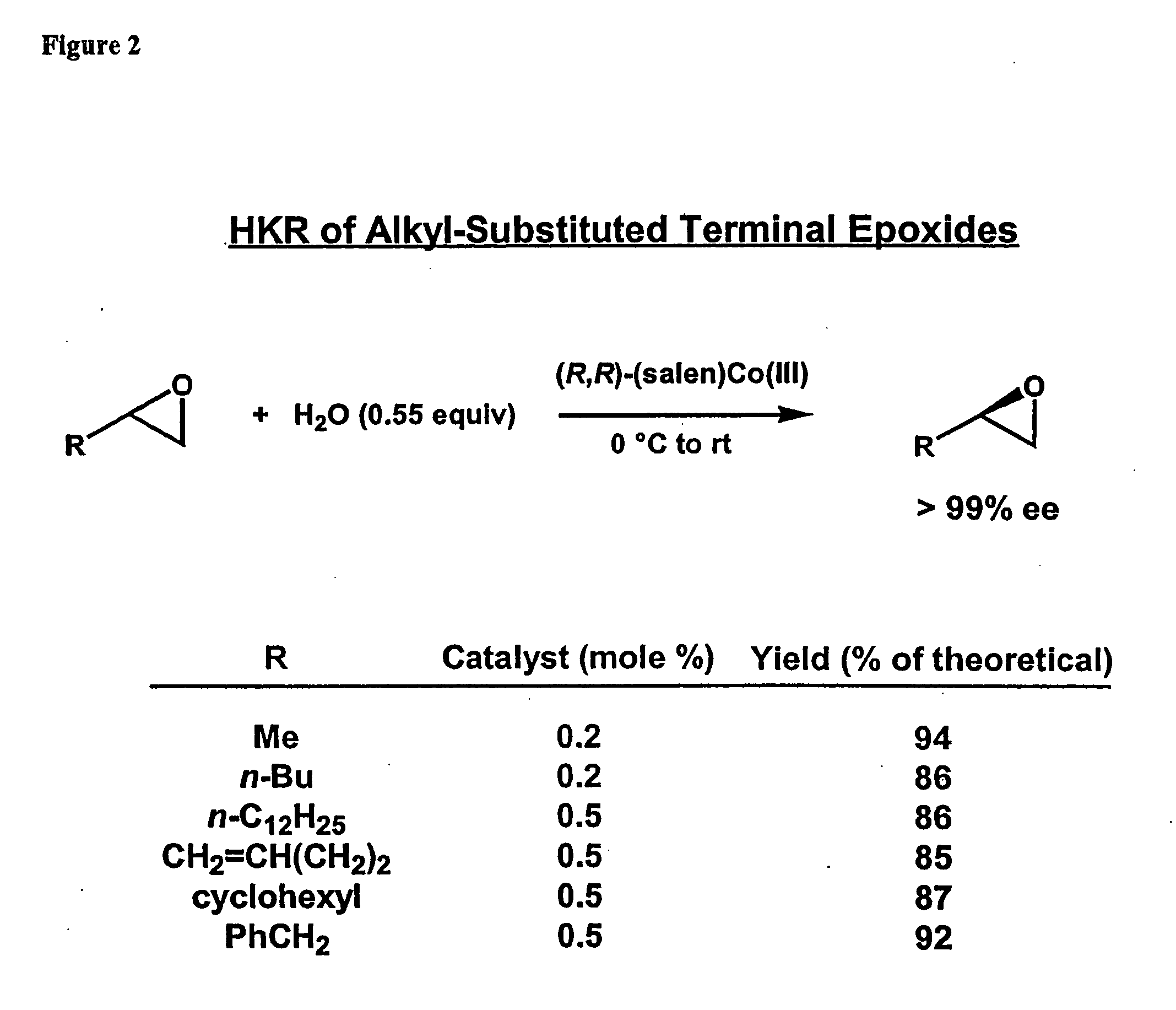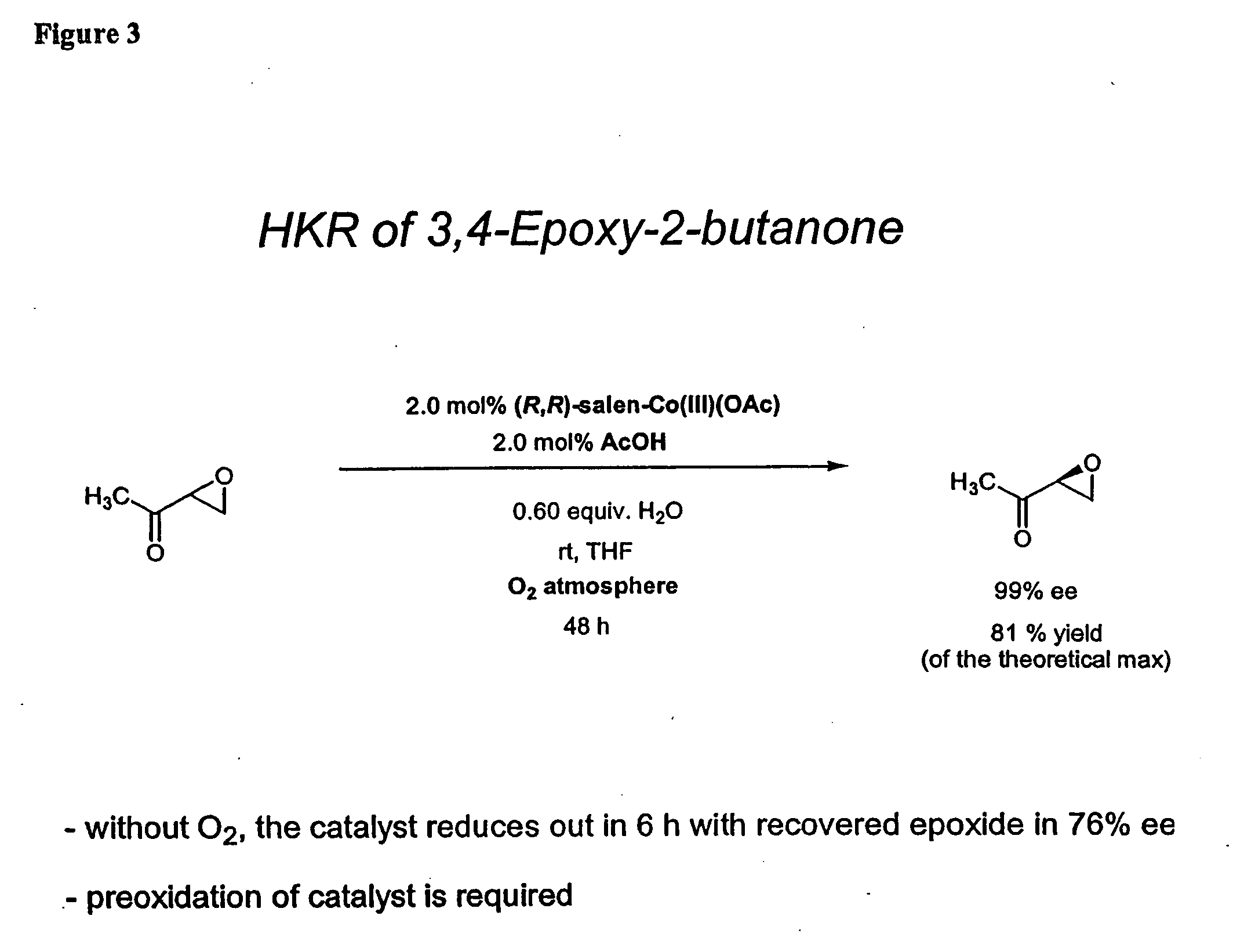Hydrolytic kinetic resolution of cyclic substrates
a technology of cyclic substrates and hydrolysis kinetics, which is applied in the separation of optically active compounds, group 3/13 element organic compounds, and group 4/14 element organic compounds, etc., and can solve the problems of wasting half of the material, inconvenient and time-consuming, and each of the methods having serious drawbacks
- Summary
- Abstract
- Description
- Claims
- Application Information
AI Technical Summary
Benefits of technology
Problems solved by technology
Method used
Image
Examples
example 1
Preparation of (R,R)-1,2-Diphenyl-1,2-bis(3-tert-butylsalicylideamino)ethane
[0257]
[0258] A solution of 360.5 mg (2.0 mmol) of 3-tert-butylsalicylaldehyde in 3 ml of EtOH was added dropwise to a solution of 212.3 mg (1.0 mmol) of (R,R)-1,2-diamino-1,2-diphenylethane in 5 ml of EtOH. The reaction mixture was heated to reflux for I h and water (5 ml) was added. The oil that separated solidified upon standing. Recrystallization from MeOH / H2O gave 485.8 mg (91%) of yellow powder, mp 73-74° C. 1H NMR (CDCl3) δ 1.42 (s, 18H, CH3), 4.72 (s, 2H, CHN═C), 6.67-7.27 (m, 16H, ArH), 8.35 (s, 2H, CH═N), 13.79 (s, 2H, ArOH) ppm; 13C NMR (CDCl3) δ 29.3, 34.8, 80.1, 117.8, 118.5, 127.5, 128.0, 128.3, 129.6, 130.1, 137.1, 139.5, 160.2, 166.8 ppm. Anal. Calcd. for C36H40N2O2. C, 81.17; H, 7.57; N, 5.26. Found: C, 81.17; H, 7.60; N, 5.25.
example 2
Preparation of (R,R)-1,2-Diphenyl-1,2-bis(3-diphenylmethylsilylsalicylideamino)ethane
[0259]
[0260] 3-(Diphenylmethylsilyl)salicylaldehyde was prepared from 2-bromophenol in 5 steps according to established procedures. A solution of 348.3 mg (1.09 mmol) of 3-(diphenylmethylsilyl)salicylaldehyde and 116.0 mg (0.546 mmol) of (R,R)-1,2-diamino-1,2-diphenylethane in 5 ml of ethanol was heated to reflux for 0.5 h. A bright yellow oil separated from the solution and it solidified upon standing. The mixture was filtered and the yellow solid was washed with 2×5 ml ethanol. The isolated yield of product pure by 1H NMR analysis was 416 mg (97%). 1H NMR (CDCl3) δ 0.95 (s, 3H), 4.68 (s, 2H), 6.72-7.55 (m, 36H, ArH), 8.37 (s, 2H), 13.34 (s, 2H) ppm.
example 3
Preparation of 2,2′-Bis(3-tert-Butylsalicylideamino)-1,1′-Binaphthyl
[0261]
[0262] A solution of 725 mg (4.0 mmol) of 3-tert-butyl-salicylaldehyde in 6 ml of EtOH was added dropwise to a solution of 569 mg (2.0 mmol) of (+)-2,2′-diamino-1,1-binaphthyl in 5 ml of EtOH. The reaction mixture was heated to reflux for 8 h and then volatile materials were removed under vacuum. The residue was purified by flash chromatography on 80 g SiO2, using 20% CH2Cl2 in hexane as eluent. The mobile yellow fraction was collected and solvents were removed under vacuum to give 725 mg (1.20 mmol, 59% yield) of the diimine as a yellow powder.
PUM
| Property | Measurement | Unit |
|---|---|---|
| temperatures | aaaaa | aaaaa |
| temperatures | aaaaa | aaaaa |
| temperatures | aaaaa | aaaaa |
Abstract
Description
Claims
Application Information
 Login to View More
Login to View More - R&D
- Intellectual Property
- Life Sciences
- Materials
- Tech Scout
- Unparalleled Data Quality
- Higher Quality Content
- 60% Fewer Hallucinations
Browse by: Latest US Patents, China's latest patents, Technical Efficacy Thesaurus, Application Domain, Technology Topic, Popular Technical Reports.
© 2025 PatSnap. All rights reserved.Legal|Privacy policy|Modern Slavery Act Transparency Statement|Sitemap|About US| Contact US: help@patsnap.com



